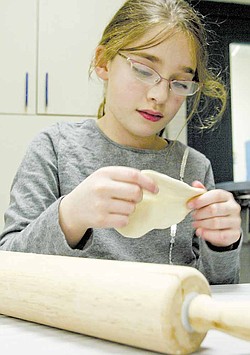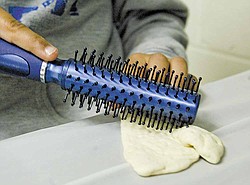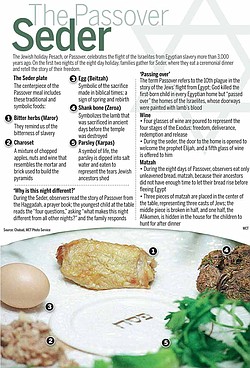Children savor rite of Passover
The Vindicator (Youngstown)
Anna Kan, a second-grader at Akiva Academy in Youngstown, prepares matzah dough. Susan Schonberger, Judaica coordinator, said the key is not to let the dough leaven or raise. Matzah, unleavened bread, is a reminder of how the ancient Israelites left Eygpt in haste and had no time to let their bread raise. Passover, which begins at sundown tonight, celebrates freedom.
The Vindicator (Youngstown)
A brand-new hairbrush punctures small holes in matzah dough to curtail the leavening process.
By LINDA M. LINONIS
YOUNGSTOWN
Passover, which begins at sundown tonight, celebrates freedom and what it took to achieve it. Jewish families mark the observance with Seder rituals in their homes and at synagogues.
Students at Akiva Academy, who represent diverse cultural, ethnic and religious backgrounds, prepared for Passover by making matzah, unleavened bread, and charoset, a sweet mixture of apples, nuts, cinnamon and grape juice.
“It’s not so much the specifics as the communality of the celebration,” said Susan Schonberger, Judaica coordinator. She said lessons focus on universal concepts such as freedom, peace and friendship.
Passover revolves around the story of the Israelites, who were slaves in Egypt, and their exodus to freedom.
Schonberger said she used the book “The Yankee at the Seder” to engage students in conversation about the Civil War. The book, based on a true story, finds a Northern soldier at a Southern Jewish home for Passover. The soldier and family share a Seder and discuss freedom. “It reflects what life is about. Passover is about the cycle of life," Schonberger said.
The teacher said she loves to watch students realize that freedom is a shared concept — the goal of the Israelites and the goal of slaves during the Civil War era. “The kids are excited about knowledge ... and the learning process,” she said.
Students participated in a Seder last week at the academy.
For Jewish students, it was a precursor to home and temple events; for others, it was a learning experience.
Tirtza Kohan, first- and third-grade teacher, described the Seder preparation as an “experience in hands-on learning.”
Schonberger said students learn about the symbolic elements on the Seder plate. They are: roasted bone, which represents an offering to God; charoset, a sweet mixture, for the mortar that enslaves Jews used to make bricks for Egy pt; hazeref, a bitter vegetable; roasted egg, symbol of sacrifice and cycle of the calendar; fresh vegetable such as parsley, celery or potato dipped into salt water for the bitterness of slavery; and matzah for three kinds of people, those not free, those who don’t care about the freedom of others and those who are free.
Schonberger said all students learn about the symbols, but it also provides a chance for non-Jewish students to share traditions from their families.
The children made matzah, unleavened bread for the Seder table.
“It’s supposed to be made in 18 minutes so it doesn’t get a chance to ferment and rise.”
The students used new hair brushes to poke holes into the matzah to lessen that chance. The matzah is a reminder of how the Israelites left Egypt in haste — they had no time for bread to rise.
Schonberger said the story of how Moses parted the Red Sea for the Israelites to escape also provides an opportunity for students to learn about water issues such as tsunami and pollution. Discussing how the Israelites survived in a desert also is a chance to talk about survival in different circumstances.
Marisa Mohapatra, 7, a second-grader, said her favorite part of the Passover story is the end when “kids get to look for matzah and get a gift.”
Jordan Sperling, 8, a second-grader, said he liked the story of the 10 plagues.
 43
43



